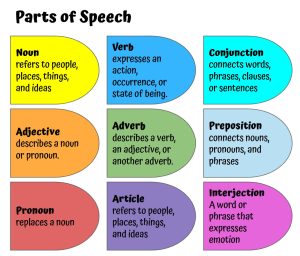19 Parts of Speech: Part 1 – Foundations
Category: Parts of Speech
Concept: Part 1 – Foundations
Connections to The Ontario Curriculum, Grades 1-8: Language (2023):
—–B3. Language Conventions for Reading and Writing
———-B3.2 Grammar
Prior Knowledge:
This chapter introduces foundational grammar, as outlined in the Language Curriculum. Teachers can determine their students’ prior knowledge by assessing what they already know and can do, and construct their lessons to correct misunderstandings, and to advance their students’ current understanding.
An understanding of what a sentence is will help students grasp that grammatical components are in part determined by their role in a given sentence.
What’s the definition?
Categories of words sorted by their grammatical and semantic functions within sentences. English contains the following common parts of speech:
- noun. A word that refers to people, places, things, and ideas.
- pronoun. A word that replaces a noun.
- verb. A word that expresses an action, occurrence, or state of being.
- adjective. A word that describes a noun or pronoun.
- adverb. A word that describes a verb, an adjective, or another adverb.
- preposition. A word that connects nouns, pronouns, and phrases.
- conjunction. A word or phrase that connects other words, phrases, or sentences, clauses.
- interjection. A word or phrase that expresses emotion. It has no grammatical connection with the sentence in which it is used.
- article. A type of adjective used before a noun to indicate whether the identity of the noun is known (definite article) or unknown (indefinite article).
The Ontario Curriculum, Grades 1-8: Language (2023)
What does it look/sound like?
The following could be used as an anchor chart to show what the nine parts of speech are, with a reminder of their function.

Parsing refers to the act of identifying the parts of speech and their role in sentences. Parsing can take many forms. One simple way to parse looks like this:

Why does it matter?
Identifying parts of speech and their role in sentences helps students develop strong language skills in the following ways:
- Build Strong Communication Skills: Grammar gives students the tools to express themselves clearly and effectively in both writing and speaking, thus preventing confusion and ensuring the intended message is accurately understood.
- Support Reading Comprehension: Understanding grammar in sentences helps students make sense of complex texts and improves overall reading fluency.
- Improve Writing / Text Quality: The ability to apply grammar well helps students write in a way that is coherent, organized, and appropriate for different audiences, in all genres.
- Encourage Clear Thinking: Learning grammar involves logic and structure, which supports critical thinking and problem-solving skills.
- Transferrable to all Subjects: Understanding grammar will help students succeed across all subject areas.
- Strengthen Language Learning: Grammar is the backbone of language. A strong grammar foundation helps students to learn additional languages.
How do I teach this?
There are many supports available to teachers for teaching the foundations or building blocks for understanding the nine parts of speech. A myriad of videos, graphics, worksheets, games, anchor charts, blogs and articles can easily be found online. Generative AI software can also assist in creating resources specifically tailored to the learning needs of your students.
A suggested course of action is to think first of assessing what your students know, understand, and can do with identifying parts of speech. Once you know where they are at, you can create multiple responses to meet their learning needs. This flow chart provides some examples.
| ASSESS what your students know and can do. | ||
| RESPOND by providing specific resources to meet their learning needs. | ||
| Tier 1 | Tier 2 | Tier 3 |
CREATE resources that will take students beyond their current understanding of parts of speech.
Sample: A pug Wrinkly and Silly Playing or Eating Adorably Winston
|
Use students’ own writing and text creation to identify parts of speech.
|
Use resources students are currently reading (in all subject areas).
|
Online Resources:
TVOlearn and TVOKids have a lot of resources to help support foundational grammar skills. For example, one animated video – Adjectives (2 min) – provides the definition and shows examples.
https://www.tvokids.com/school-age/videos/homework-zone-language/adjectives-video
There are many online games you can find and use with your students, like this one, Parts of Speech Invasion.
https://www.wordgametime.com/games/parts-of-speech-invasion#google_vignette
Another approach is to have the students do the teaching, as suggested in this edutopia article, To make the parts of speech engaging, have students do the teaching, by Dana Haring (2022).
https://www.edutopia.org/article/make-parts-speech-engaging-have-students-do-teaching/
Parsing is an effective strategy to help students build their understanding and fluency with parts of speech identification. This video provides an example.
A sentence consisting of one independent clause.


